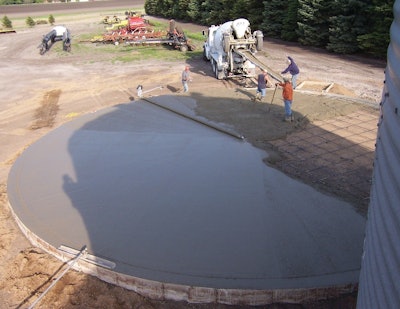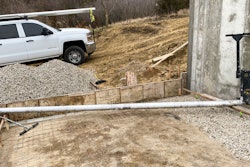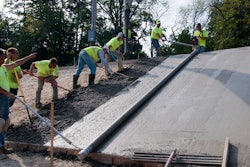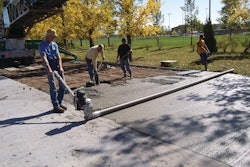
Concrete contractors encountering circular slabs may be concerned with how to do the most efficient screeding possible. One way to make screeding circular slabs easier is to use the Lightning Strike roller screed from Lura Enterprises.
Northern Grain Equipment, West Fargo, N.D., has a concrete division that offers total grain system services. This includes pouring circular grain bin floors, says Foreman Justin Schmidt. These bins hold corn and other grains and can be used for drying and/or storing the grain.
A typical circular grain bin floor is about 48 feet in diameter, Schmidt says. But sometimes larger slabs are needed - Northern Grain recently completed a 75-foot-diameter grain bin floor.
The prep for a circular grain bin floor starts with compacting the fill. "We make sure there is at least 100 percent compaction so there is no chance of the floor cracking," Schmidt says. If the bin is going to be used for drying, an aeration system is set up under the floor so air can circulate through the grain. After the aeration system is in place, rebar is then placed for the concrete floor.
If the bin has a conveyor underneath to transport grain, steel decking is placed over the rebar to prevent the concrete from collapsing into the conveyor tunnel during the pour. Then a second layer of rebar is placed over the steel decking, Schmidt says.Once prep is done and rebar is in place, the concrete is poured. And once the pour is complete screeding can start. To make the screeding process easier, Northern Grain use the Lightning Strike roller screed, Schmidt says. "It's very versatile, lightweight, and seems to be the best fit for what we do," he says. "It makes screeding more efficient, we can use less people, and it takes less than half the time to use to."
Using the screed on a circular slab is simple, Schmidt says. A base plate is set into the floor before pouring. The Lightning Strike screed is connected to a shaft placed in the base plate and a center pin is placed into the shaft. The center pin holds the screed to the concrete and allows for one-person circular screeding, he explains. When finished, the screed, pin and shaft are removed and a small amount of concrete must be filled in. The base plate remains in place under the concrete.
On larger pours, instead of using the center pin two people operate the screed - one on each side - doing multiple straight section pulls. "You could potentially do a larger bin in a circular pattern, but it's better to do it in shorter sections so the concrete is finished more efficiently and you aren't getting cold joints in the concrete," Schmidt says. Plus, adding extensions to make the aluminum screed span longer than 26 feet could result in a little flexing of the screed, Schmidt adds.
Doing straight pulls does result in odd, pie-shaped sections on the ends of the circular slab. "We float these areas by hand with a regular 2 x 4 screed board," Schmidt says. Finally, Schmidt uses walk-behind power trowels for an even, smooth finish on the floor.
Schmidt uses the Lura screed whenever he can, which is why the company owns three models - two gas and one electric. And it doesn't look like these screeds will be getting any rest soon. "In our area the agricultural construction market is really booming," Schmidt says. "Right now we're looking at potential sales out through the next year already. We're expecting almost double the sales next year of what we did this year."
Do you have a project you would like Concrete Contractor to consider for "On the Job"? E-mail your idea to Kim Johnston at [email protected].



















